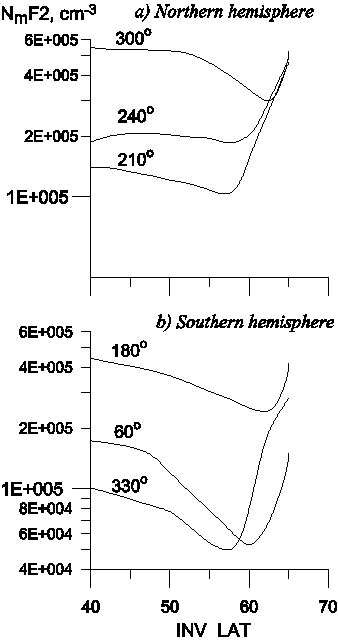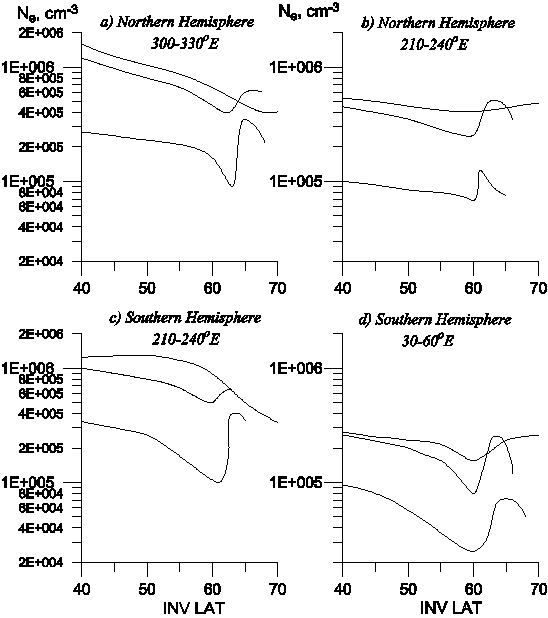
|

Pushkov Institute of Terrestrial Magnetism, Ionosphere and Radio Wave Propagation Russian Academy of Sciences ( founded in 1939 ) |

|
| Language [RU/EN] |
| Home | UP | Research | Projects | Services | Info | News | Events | Personal | Archive |
|
The dependence of the main ionospheric trough shape on longitude, altitude, season, local time, and solar and magnetic activityA. T. KarpachevInstitute of Terrestrial Magnetism, Ionosphere, and Radiowave Propagation, Russian Academy of Sciences, Troitsk, Moscow region, 142190 Russia e-mail: karp@izmiran.ru Pages: 1 | 2 | 3 | 4 | 5 To simplify an analysis, we compare three most typical longitudinal sectors in the Northern (210, 240, and 300o) and Southern (60, 180, and 330o) hemispheres (see Fig. 3). The concentration in the entire region of the trough is maximum in the Northern Hemisphere at a longitude of 300o. A trough minimum shifted poleward over the largest distance, and a general decrease in the plasma concentration is most considerable. Therefore, the most developed trough with a width of 12o and a depth of 1.7 is detected here. This is also evident in Fig. 2a, which shows the variations in the trough depth and width. On the contrary, at longitudes of about 210o the plasma concentration in the trough is minimum and slightly varies with latitude; therefore, the trough is wide (17o) and shallow (1.25) here. The trough is exhausted at a longitude of 240o because the amplitudes and phases of the NmF2 longitudinal variations in the Northern Hemisphere vary in such a way that the NmF2 profiles intersect at longitudes of about 240o (see Fig. 2a). In the Southern Hemisphere, the concentration in the trough region is maximum at longitudes of about 180o and a trough minimum is shifted poleward. Therefore, the MIT characteristics are similar to the characteristics of the analogous sector near 300o in the Northern Hemisphere. On the contrary, at a longitude of about 330o the concentration in the trough is low and a trough minimum is located most closely to the equator. Here the electron concentration varies with latitude in such a way that a narrow (9o) and shallow (1.4) trough is finally formed. 
The longitudinal sector 30-60o in the Southern Hemisphere is peculiar. The trough depth increases sharply (up to 3.0) in this sector as compared to the adjacent longitudes, again due to the latitudinal changes in the character of LE on NmF2 (see Fig. 2b). Thus, the features revealed in the MIT behavior are related to the manifestation of global LE rather than to the trough formation mechanism. The LE character depends mainly on the geomagnetic field parameters and on the neutral wind [Deminov and Karpachev, 1988]. The velocities and phases of the meridional and zonal components of the neutral wind vary with local time; therefore, the character of LE should also vary. The conclusions drawn above hold true only for near-midnight hours. The errors in determining the trough depth and width are related to the same factors because Intercosmos-19 satellite data were averaged over a rather wide time interval (0000-0200 LT). Thus, the trough depth in the Northern and Southern hemispheres varies from 1.1 to 1.7 and from 1.4 to 3.0, respectively. The trough width counted from the inflection point varies from 7o to 17o and from 9o to 18o in the Northern and Southern hemispheres, respectively. Seasonal variations in the MIT shape (or speaking more generally, the Ne variations in the MIT region) were considered in detail by Besprozvannaya [1975] and Tulunay [1973]. They determined that nighttime MIT exists regularly under winter equinoctial conditions but is formed only at isolated longitudes under summer conditions. Besprozvannaya [1975] stated that MIT is observed at western longitudes of the Northern Hemisphere. Tulunay [1973] analyzed separately longitudinal zones of 0-180o, 260-320o, 320-360o and 180-260o in either hemisphere. The reasons for such a choice are obscure because it is independent of the LE character in the Northern and Southern hemispheres. Intercosmos-19 and Cosmos-900 data make it possible to determine the most characteristic longitudinal sectors in both hemispheres. These longitudes are 210-240o and 300-330o in the Northern Hemisphere, where Ne in all seasons is minimal and maximal, respectively and the distance of a trough minimum from the pole is the largest and the smallest, respectively. Similar longitudinal sectors in the Southern Hemisphere are 30oW-90oE, as well as 150-210o E (in winter) and 240-300o E (in summer). Therefore, in the Southern Hemisphere, we will consider the 30-60o and 210-240o longitudinal sectors (see Fig. 4). 
Cosmos-900 data shown in Fig. 4 correspond the near-midnight (2300-0100 LT)
quiet (Kp <= 2) conditions of high solar activity (F10.7 ~ 200).
They were obtained in December 1978 and January 1979. A characteristic feature of the
210-240o longitudinal sector in the summer Southern
Hemisphere is the presence of the so-called ionization "cliff", i.e., the increase in Ne at
latitudes of 50-55o, which changes into the sharp decrease
in Ne towards the auroral oval. The level of Ne at longitudes of
300-330o in the Northern Hemisphere is also high in summer;
however, "cliff" is not formed, and Ne monotonously decreases towards high latitudes.
The causes of such an Ne behavior were considered by Karpachev [1995, 1996]. In the equinox
conditions, the background concentration decreases not very strongly as compared to the
summer conditions. Nevertheless, a pronounced trough with a minimum at latitudes of
~63o and 62o in the Northern
and Southern hemispheres, respectively, is formed at the longitudes in question, since in the
nonsunlit period the "length" of the shadow becomes considerably larger than in summer
and the trough has got enough time to be formed. The MIT width in near-midnight hours is
~8o and 8o and the depth
is 1.6 and 1.4 in the Northern and Southern hemispheres, respectively. In winter the
background concentration in both hemispheres decreases at all latitudes but especially
strongly at a trough minimum. Therefore, MIT becomes deeper: up to 2 and 2.6 in the
Northern and Southern hemispheres, respectively. MIT becomes narrower
(5o) and wider (12o) at
longitudes of 300-330o and 210-240o in
the Northern and Southern hemispheres, respectively.
|
 |
|
(C) 2007, IZMIRAN
|

